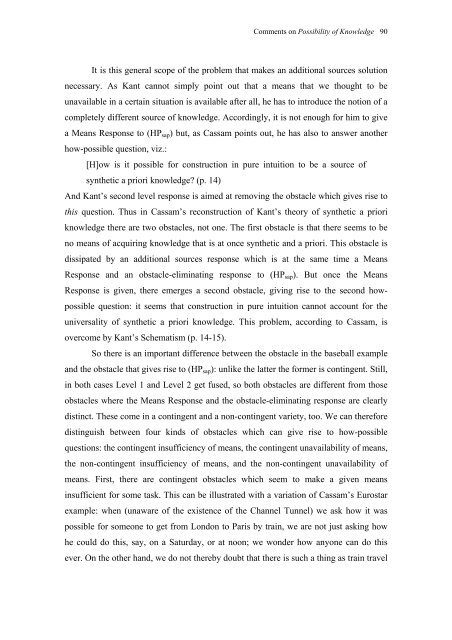Complete Issue in PDF - Abstracta
Complete Issue in PDF - Abstracta
Complete Issue in PDF - Abstracta
Create successful ePaper yourself
Turn your PDF publications into a flip-book with our unique Google optimized e-Paper software.
Comments on Possibility of Knowledge<br />
It is this general scope of the problem that makes an additional sources solution<br />
necessary. As Kant cannot simply po<strong>in</strong>t out that a means that we thought to be<br />
unavailable <strong>in</strong> a certa<strong>in</strong> situation is available after all, he has to <strong>in</strong>troduce the notion of a<br />
completely different source of knowledge. Accord<strong>in</strong>gly, it is not enough for him to give<br />
a Means Response to (HPsap) but, as Cassam po<strong>in</strong>ts out, he has also to answer another<br />
how-possible question, viz.:<br />
[H]ow is it possible for construction <strong>in</strong> pure <strong>in</strong>tuition to be a source of<br />
synthetic a priori knowledge? (p. 14)<br />
And Kant’s second level response is aimed at remov<strong>in</strong>g the obstacle which gives rise to<br />
this question. Thus <strong>in</strong> Cassam’s reconstruction of Kant’s theory of synthetic a priori<br />
knowledge there are two obstacles, not one. The first obstacle is that there seems to be<br />
no means of acquir<strong>in</strong>g knowledge that is at once synthetic and a priori. This obstacle is<br />
dissipated by an additional sources response which is at the same time a Means<br />
Response and an obstacle-elim<strong>in</strong>at<strong>in</strong>g response to (HPsap). But once the Means<br />
Response is given, there emerges a second obstacle, giv<strong>in</strong>g rise to the second howpossible<br />
question: it seems that construction <strong>in</strong> pure <strong>in</strong>tuition cannot account for the<br />
universality of synthetic a priori knowledge. This problem, accord<strong>in</strong>g to Cassam, is<br />
overcome by Kant’s Schematism (p. 14-15).<br />
So there is an important difference between the obstacle <strong>in</strong> the baseball example<br />
and the obstacle that gives rise to (HPsap): unlike the latter the former is cont<strong>in</strong>gent. Still,<br />
<strong>in</strong> both cases Level 1 and Level 2 get fused, so both obstacles are different from those<br />
obstacles where the Means Response and the obstacle-elim<strong>in</strong>at<strong>in</strong>g response are clearly<br />
dist<strong>in</strong>ct. These come <strong>in</strong> a cont<strong>in</strong>gent and a non-cont<strong>in</strong>gent variety, too. We can therefore<br />
dist<strong>in</strong>guish between four k<strong>in</strong>ds of obstacles which can give rise to how-possible<br />
questions: the cont<strong>in</strong>gent <strong>in</strong>sufficiency of means, the cont<strong>in</strong>gent unavailability of means,<br />
the non-cont<strong>in</strong>gent <strong>in</strong>sufficiency of means, and the non-cont<strong>in</strong>gent unavailability of<br />
means. First, there are cont<strong>in</strong>gent obstacles which seem to make a given means<br />
<strong>in</strong>sufficient for some task. This can be illustrated with a variation of Cassam’s Eurostar<br />
example: when (unaware of the existence of the Channel Tunnel) we ask how it was<br />
possible for someone to get from London to Paris by tra<strong>in</strong>, we are not just ask<strong>in</strong>g how<br />
he could do this, say, on a Saturday, or at noon; we wonder how anyone can do this<br />
ever. On the other hand, we do not thereby doubt that there is such a th<strong>in</strong>g as tra<strong>in</strong> travel<br />
90




